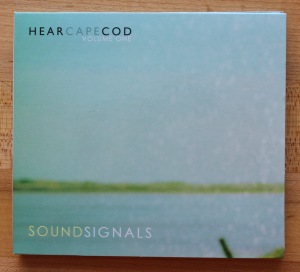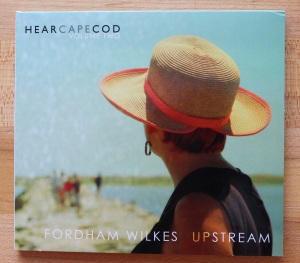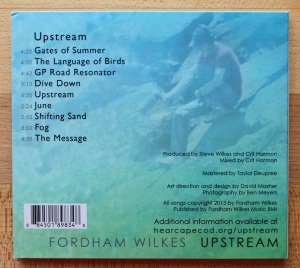Drummassage
CD: 68bpm 001 Time: 41:26
Website: http://drummassage.com/ (Purchase option links at website will be “live” as of 4/28/15)
Tracks: Chimes (Intro), 68BPM, Interlude, Rolls, Heartbeat I, Chimes Coda, Heartbeat II
Performed by Phil Didlake, Leah Gramsjohnson, Isabella Iatarola, Tessa Kaslewicz, Ben Meyers, Clara Natonabah and Steve Wilkes, with support from the Berklee College of Music. Field recordings from the Hear Cape Cod project
****
Something a bit different from our standard music review…what is known as “functional music.”
Whether by means of self-hypnosis, meditation (such as TM) or other approaches, there is a point where the body and mind can achieve a surprising state of awareness in the midst of a deep calm. Along with others, Dr. Herbert Benson used the term The Relaxation Response to describe a multi-step process for achieving this state. One method to assist with relaxation is by using various forms of music. I can attest anecdotally to the healing and calming powers of certain forms of music.
The Drummassage album is an outgrowth of a project started by Steve Wilkes (a faculty member at the Berklee College of Music in Boston, Massachusetts). Some may recall that Steve Wilkes and Ginny Fordham brought us their Hear Cape Cod project in 2013, a set of field recordings accompanied with remixes by many well-known ambient and experimental musicians as well as a companion album of songs inspired by Cape Cod (another in that series will be released later in 2015).
Drummassage started as an informal gathering and exploration of the possible healing and calming power of drums and drumming at Wilkes’s Berklee studio (an aside: Berklee offers various degrees and concentrations in music therapy). As work advanced on the project and became better known, performances were held at venues around the Berklee community for larger groups with participants placed within drum circles along with the percussionists. Native American drums made with indigenous woods of various types in Wilkes’s collection are used in these recordings. Instrumentation is all-acoustic, and the performances include quiet repetitive and low frequency rhythms with occasional counterpoint from other ambient percussion.

This first recording is in stereo (two channel) with the ultimate goal to produce additional recordings using surround-sound 5.1 mixes to more accurately replicate the experience of participating in the actual performances and therapy sessions. The stereo version is quite effective and Wilkes recommends using either a high quality audio system or headphones to obtain the best sonic results.
Since I have experience with inducing the relaxation response from having practiced self-hypnosis for many years (although not nearly as often as I should!), I can confirm that this stereo recording is quite effective. Often, I found the greatest relaxation being achieved (surprisingly) during the more active rhythm sections. Frequently, I lost a sense of time and either drifted to a deeper meditative state, off to sleep (which is permitted!) or found myself relating visual memories to the sounds during to the interludes (which have field recording excerpts).
The CD has a brief spoken-word introduction mixed with resonant wind chimes. There are three sections (68BPM, Heartbeat I and Heartbeat II) of extended slow muted trance-inducing rhythmic drumming (these will be especially effective if the listener’s sound system also includes a sub-woofer). Interlude is a brief rain shower with thunder, followed by Rolls, a series of building thundering washes (reminiscent of a passing storm). Outdoor sounds (chirping evening insects) return just before Heartbeat I begins.
Heartbeat I builds slowly, first a simple three beats and rest, then a layer of triplets is added to create a pulsing that is later supplemented with what sounds like rain-sticks before diminishing to the straight beat. The last interlude, Chimes Coda passes through with a gentle mix of environmental recordings. The final session, Heartbeat II, reintroduces the foundational three beat and rest pattern, which transforms again into a series of three triplets and a diddle (percussion rudiment term, two struck notes in succession instead of three). Periodically shaken percussion is added. For those who haven’t intentionally tried to induce a relaxation response before, it’s quite an unexpectedly pleasurable and invigorating experience (and can be habit-forming too). It can also improve one’s sense of awareness following a session.
There will be a CD release event and performance at 7PM on April 28, 2015 at The Red Room @ 939, in Boston, Massachusetts located at 939 Boylston Street.
This is a solicited review.
Review: HearCapeCod – SoundSignals and Upstream
Volume One – SoundSignals – #HCC001
Notes and Detailed Credits: http://hearcapecod.org/soundsignals/
CD 1 (Time: 39:08): Sound Signals: Act 1: On Land, Act II: On Water, Act III: A Year, Coda: Route Six
CD 2 (Time: 46:24): Signals Remixed: 1: Goldmund, 2: Marcus Fischer, 3: Loscil, 4: Taylor Deupree, 5: Neara Russell, 6: FourColor, 7: Steve Wilkes, 8: Simon Scott, 9: FourColor & SoundSignal
Volume Two – Upstream by Fordham Wilkes – #HCC002
Notes and Detailed Credits: http://hearcapecod.org/upstream/
CD (Time: 37:08): 1) Gates of Summer, 2: The Language of Birds, 3: GP Road Resonator, 4: Dive Down, 5: Upstream, 6: June, 7: Shifting Sand, 8: Fog, 9: The Message
Websites: http://hearcapecod.org/ & http://www.fordhamwilkes.com/
Sound Archive: http://www.hearcapecod.org/ListView.php
Recordings mastered by Taylor Deupree at 12k Mastering
Since the middle of 2011, Berklee College of Music professor, percussionist and Blue Man Group alum, Steve Wilkes has been working on a project to capture the sounds of Cape Cod over a year and to map those sounds as an aural history of the region (the far eastern end of Massachusetts in the northeastern United States). The project was funded in part by the Newbury Comics Faculty Fellowship. The region has undergone many environmental and man-made changes, from rising sea levels and coastal erosion to residential development. It was Wilkes’ feeling that the region is measured and analyzed in many ways (like bird population counts, temperature and sea levels), but there was yet to be a base-line environmental sound analysis examining animal, environmental and cultural activity in the region.
At this point, the project consists of 3 CDs: 1, a collection of regional sounds; 2, the sounds remixed by a number of musicians who will be familiar to many, and 3, a song-cycle inspired by the region at various times throughout the year (which also incorporates many of the environmental sound recordings and the detailed credit links give an excellent overview of the variety on-location recordings). The album artwork evokes pleasant memories of worn edged blue-green beach-glass.
CD 1 is a sonic time capsule, and at first it reminded me of a number of sound effects and spoken word recordings of the 1940s and 50s, and for a brief moment, I thought I was hearing a snippet of the old records by Bert and I. It also had the immediate effect of taking me back in time to the days when I summered on “The Cape” as a child with my parents in the early 1960s. The documentation of the region also harkens back to some of the expansive sound archive work by Alan Lomax. This CD chronicles the sounds of land, water and activities that mark the course of a year from a First Night Noise Parade to the calming summertime beach surf. It closes with the reading of the poem Route Six by Stanley Kunitz (being the road that travels down the center of the “flexed arm” of Cape Cod, reaching out into the Atlantic Ocean).
Having lived in a beach-town region in nearby southern Connecticut, I am also reminded that a resort region like The Cape has two lives—the times when the summer-folk occupy and the off-season when only the locals remain. The off-season is the time when locals can take long walks on the shore beaches and see very few people. Life goes on in a different way after the tourists have left in the autumn.
Taylor Deupree’s Remix
Wind Chimes Field Recording That Inspired TD’s Remix
CD 2 is a sensitively created set of interpretive remixes by many well known artists in the current electro-acoustic, ambient and electronic music communities (see list above). The field recordings from CD 1 are delightfully co-mingled with the offerings from each of the artists (well documented at the web link also noted above). I was immediately struck by the opening notes of the first track by Goldmund (Keith Kenniff), the piano melody being very reminiscent of Anthony Phillips’ Death of a Knight from Henry: Portrait from Tudor Times (from the album The Geese and The Ghost), before drifting into a dream-state with seaside, night-time crickets and Morse Code pulses.
FourColor Remix
Field Recording for FourColor Remix
Most of the remixes are by artists who have done work strongly connected with outdoor environs and water (as in the Flaming Pines label Rivers Home series), like Marcus Fischer, Taylor Deupree and Simon Scott (to name a few). The character of this disc ranges from contemplative to glitchy (FourColor) to playfully rhythmic (as in Loscil’s remix). The remix by Steve Wilkes includes the first HearCapeCod recording made in Truro at Corn Hill Beach in the summer of 2002. The CD closes with a collaboration of FourColor and SoundSignal (Wilkes) and is the most melodic and rhythmic of the tracks of the album. This CD forms a strong connection to the foundation provided by Wilkes’ research and recordings. As much as I’m tempted to suggest that this CD be made available separately, after spending time with the entire set, it is actually a quite inseparable part of the whole.
CD 3 Upstream, is a song cycle by the duo Fordham Wilkes (Ginny Fordham: vocals, Steve Wilkes: drums with Crit Harmon: guitars and Keiichi Sugimoto: guitars) and is inspired by years of memories of time on Cape Cod and it is the most personal of the three discs. Fond recollections of places run deep for many and they have different effects on people. This is where the project transforms from being objective (CD 1) to the most reflective and personal (while avoiding sentimentality).
The album has a sense of welcoming and ease, enjoying summer breezes, wading in tidal pools, walking in sanctuaries or along beaches. There is no heavy foreboding or hand-wringing of what was or could be; the feeling is that of the now and hopefulness, and Ginny Fordham’s voice brings a relaxing calm to the album. Gates of Summer opens CD3 and is forms an instrumental and melodic transition from the last track of CD2. The Language of Birds plays rhythmically with a juxtaposition and syncopation of the instrumentation and avian field recordings.
GP Road Resonator
The Field Recording Forming Basis for GP Road Resonator
The ever-present drone of automobile traffic is also a reality of summers on The Cape (whether passing over the Sagamore or Bourne bridges before necking down to Route 6 or at the half-way point to Provincetown, in Eastham) and these sounds are merged with fleeting views to salt marshes in the pensive GP Road Resonator. As in CD 1, there are songs of Land as well as Water, as in Dive Down and Upstream (as much a metaphor for returning to and rebirth of the area as it is the traffic on Route 6 that one is “swimming” against!).
CD 3 is also a reflection of CD 1’s A Year, The Cape in song over the course of a single circumnavigation of our Earth around the Sun. As the album progresses through the summer and into the end of a year (June, Shifting Sand and Fog) it grows more contemplative with the advancing of the calendar, melding dreams with reality. Each Spring many look forward the approaching time outside and then seemingly in the blink of an eye, Summer is over. The album closes with The Message, an inspiration left in a voicemail, which ultimately is the beacon announcing the sense of place of The Cape that inspired the HearCapeCod project.
****
The release date (May 28, 2013) for this set is at the unofficial “gate of summer” season, just after Memorial Day weekend. These albums will be available at: Booksmith Musicsmith, Orleans, MA: https://www.facebook.com/BooksmithMusicsmith , Muir Music, Provincetown, MA: https://www.facebook.com/muirmusic5 , The Cape Cod Museum of Natural History: http://ccmnh.org/, CD Baby: SoundSignals On CD Baby, iTunes: http://www.apple.com/itunes/ and Amazon.com: http://www.amazon.com/






